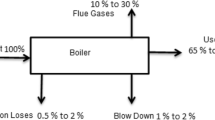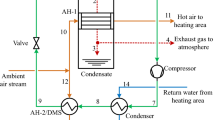Abstract
Commercial buildings account for significant portions of the total building energy in South Korea and thus a variety of research on the boiler operation related to heating energy in office buildings has been carried out thus far. However, most of the researches have been conducted on the boiler itself, i.e., the part load ratio characteristics and the corresponding gas energy consumption patterns are not analyzed in the existing studies. In this study, the part load ratio and the operating characteristics of gas boiler have been analyzed within an office building equipped with the conventional variable air volume system. In addition, the gas consumption among different boiler staging schemes has been comparatively analyzed. As a result, significant portions of total operating hours, heating load and energy consumption has been found to be in a part load ratio range of 0 through 40% and thus energy consumption is significantly affected by boiler efficiency at low part load conditions. This suggests that boiler operation at the part load is an important factor in commercial buildings. In addition, utilizing sequential boiler staging scheme can save a gas usage of about 7%. For annual heating energy saving, applying the sequential control boiler with a 3:7 proportion staging is considered to be the optimal control algorithm for maximum efficiency of boilers.
Similar content being viewed by others
References
Kim T H, Jung Y S, Jung H G. A trend analysis of greenhouses gas reduction technique development for building sector in Korea. In: Proceedings of the fall conference of the Architectural Institute of Korea, Busan, Republic of Korea, 2016, 716–717
Pak J H. World energy market insight weekly. Korea Energy Economics Institute. 2016–5–16, http://211.35.39.23:8089/search/search_homepage/search.jsp
Lee S J. Post 2020 types of greenhouse gas reduction contribution. Korea Energy Economics Institute, 2016
Seo J H. Energy saving in boiler. Journal of Korean Association of Air Conditioning Refrigerating and Sanitary Engineers, 2009, 26: 51–59
Murray S N, Walsh B P, Kelliher D, O’Sullivan D T J. Multivariable optimization of thermal energy efficiency retrofitting of buildings using static modelling and genetic algorithms — a case study. Building and Environment, 2014, 75: 98–107
Weissmann C, Hong T, Graubner C A. Analysis of heating load diversity in German residential districts and implications for the application in district heating systems. Energy and Building, 2017, 139: 302–313
Giurca I, Badea G, Aşchilean I, Naghiu G S, Megyesi E. Selecting the number and size of boilers used within the heating units of the residential complexes. Energy Procedia, 2017, 112: 134–141
Wu S, Li J. Intelligent and optimal control of energy saving of gas boiler group. In: 2nd International Conference on Computer Engineering and Technology, Chengdu, China, 2010, 50–54
Wei D, Chen A, Sun B, Zhang C. Multi-objective optimal operation and energy coupling analysis of combined cooling and heating system. Energy, 2016, 98: 296–307
Lazzarin R M. The importance of the modulation ratio in the boilers installed in refurbished buildings. Energy and Building, 2014, 75: 43–50
Yu B H, Seo B M, Moon J E, et al. Analysis of part load ratio characteristics and gas energy consumption of a hot water boiler in a residential building under Korean climatic conditions. Journal of The Society of Air-conditioning and Refrigerating Engineers of Korea, 2015, 27: 455–462
Seo B M, Lee K H. Detailed analysis on part load ratio characteristics and cooling energy saving of chiller staging in an office building. Energy and Building, 2016, 119: 309–322
Son J E, Lee K H. Cooling energy performance analysis depending on the economizer cycle control methods in an office building. Energy and Buildings, 2016, 120: 45–57
Yoon Y B, Kim D S, Lee K H. Detailed heat balance analysis of the thermal load variations depending on the blind location and glazing type. Energy and Buildings, 75: 84–95
The US Department of Energy. EnergyPlus Engineering Reference. The Reference to EnergyPlus Calculations. 2014, http://www. energyplus.gov
Lee D Y, Seo B M, Kwon H J, et al. Heating performance and partial load ratio characteristics of boiler staging in office building. In: Proceedings of the Summer Conference of The Society of Airconditioning and Refrigerating Engineers of Korea, Pyungchang, Republic of Korea, 2017, 321–324
American Society of Heating. Refrigerating and Air-conditioning Engineers. ASHRAE Standard 90.1. Energy Standard for Buildings Except Low-Rise Residential Buildings, 2004
Sohn J Y, Kim S H, Ahn B W, et al. Multiple units control of boiler and refrigerator HVAC system. Journal of the Society of Airconditioning and Refrigerating Engineers of Korea. 1992, available at auric website
Acknowledgements
This work was supported by the Korea Institute of Energy Technology Evaluation and Planning (KETEP) and the Ministry of Trade, Industry & Energy (MOTIE) of the Republic of Korea (No. 20163030111350), and the Human Resources Development of the Korea Institute of Energy Technology Evaluation and Planning (KETEP) grant funded by the Korea government Ministry of Trade, Industry & Energy (No. 20184030201900).
Author information
Authors and Affiliations
Corresponding author
Rights and permissions
About this article
Cite this article
Lee, D.Y., Seo, B.M., Yoon, Y.B. et al. Heating energy performance and part load ratio characteristics of boiler staging in an office building. Front. Energy 13, 339–353 (2019). https://doi.org/10.1007/s11708-018-0596-5
Received:
Accepted:
Published:
Issue Date:
DOI: https://doi.org/10.1007/s11708-018-0596-5




